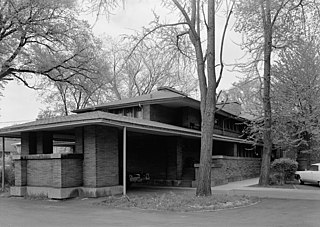
The Darwin D. Martin House Complex, also known as the Darwin Martin House National Historic Landmark, was designed by Frank Lloyd Wright and built between 1903 and 1905. Located at 125 Jewett Parkway in Buffalo, New York, it is considered to be one of the most important projects from Wright's Prairie School era, and ranks along with The Guggenheim in New York City and Fallingwater in Pennsylvania among his greatest works.

The Charles Pinckney National Historic Site is a unit of the United States National Park Service, preserving a portion of Charles Pinckney's Snee Farm plantation and country retreat. The site is located at 1254 Long Point Road, Mount Pleasant, South Carolina. Pinckney (1757-1824) was a member of a prominent political family in South Carolina. He fought in the American Revolutionary War, was held for a period as prisoner in the North, and returned to the state in 1783. Pinckney served as a delegate to the constitutional convention where he contributed to drafting the United States Constitution.
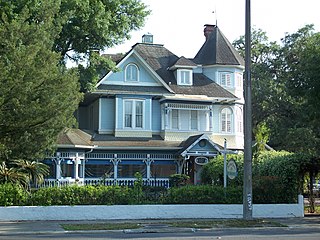
The Mary Phifer McKenzie House, now the Sweetwater Branch Inn Bed and Breakfast, is an historic house located at 617 East University Avenue in Gainesville, Florida. It was added to the National Register of Historic Places in 1982.

Mary Todd Lincoln House in Lexington, Kentucky, USA, was the girlhood home of Mary Todd, the future first lady and wife of the 16th President, Abraham Lincoln. Today the fourteen-room house is a museum containing period furniture, portraits, and artifacts from the Todd and Lincoln families. The museum introduces visitors to the complex life of Mary Todd Lincoln, from her refined upbringing in a wealthy, slave-holding family to her reclusive years as a mourning widow.

Oatlands Historic House and Gardens is an estate located in Leesburg, Virginia. Oatlands is operated by the National Trust for Historic Preservation and is listed on the National Register of Historic Places as a National Historic Landmark. The Oatlands property is composed of the main mansion and 415 acres of farmland and gardens. The house is judged one of the finest Federal period country estate houses in the nation.

Roseland Cottage, also known as Henry C. Bowen House or as Bowen Cottage, is a historic house located on Route 169 in Woodstock, Connecticut. The house was added to the National Register of Historic Places in 1977, and was declared a National Historic Landmark in 1992. It is described as one of the best-preserved and best-documented Gothic summer houses in the nation, with virtually intact interior decorations.

The Magnolia Mound Plantation House is a French Creole house constructed in 1791 near the Mississippi River in Baton Rouge, Louisiana. Many period documents refer to the plantation as Mount Magnolia. The house and several original outbuildings on the grounds of Magnolia Mound Plantation are examples of the vernacular architectural influences of early settlers from France and the West Indies. The complex is owned by the city of Baton Rouge and maintained by its Recreation Commission (BREC). It is located approximately one mile south of downtown.

Crystal Lake State Park is a day-use state park and historic site in Barton, Vermont, United States. It is located at 96 Bellwater Avenue, off Willoughby Lake Road just east of the village, at the northwestern end of 763-acre (309 ha) Crystal Lake. It features a sandy beach with swimming area, and a bath house built by the Civilian Conservation Corps (CCC). A cottage is available for rental. The park was added to the U.S. National Register of Historic Places on August 30, 2005, for its association with the CCC.

The Charles Payne House is an historic site in Pawtucket, Rhode Island. The house was built in 1855–56 by Charles Payne and later expanded with the addition of two ells and a porch. The 1 1⁄2-story Gothic-Italianate vernacular cottage is architecturally significant as a 19th-century vernacular cottage in a picturesque setting. Though the round-head picket fence and entry gates were later removed, the property retains a large shaded garden on with ample street frontage. The Charles Payne House was added to the National Register of Historic Places in 1983.
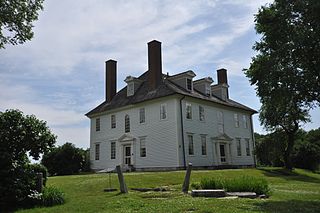
The Jonathan Hamilton House, also known as the Hamilton House, is a historic house at 40 Vaughan's Lane in South Berwick, Maine. Built between 1787 and 1788 by a merchant from Portsmouth, New Hampshire, this National Historic Landmark is a little-altered and high quality late Georgian country house. Acquired by preservationist friends of South Berwick native Sarah Orne Jewett at the turn of the 20th century, it is now a historic house museum owned by Historic New England, open for tours between June and October.
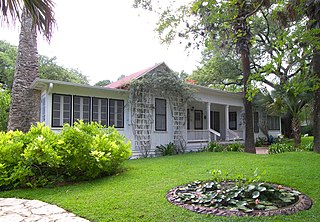
The Mayfield–Gutsch Estate, now named Mayfield Park, is a historic cottage, gardens and nature preserve in west Austin, Texas on a bluff overlooking Lake Austin. Originally built in the 1870s, the cottage was purchased by former Texas Secretary of State Allison Mayfield in 1909. In 1922, the house passed to Mayfield's daughter, Mary Frances, and her husband, University of Texas professor Milton Gutsch. They expanded the home, adding porches on three sides and, with the help of gardener Esteban Arredondo, greatly developed 2 acres (0.81 ha) of the property around their home into a botanical garden surrounded by a rock perimeter wall. When Mary Mayfield Gutsch died in 1971, the home and grounds were left to the City of Austin for use as a park. The property was listed on the National Register of Historic Places on September 29, 1994.
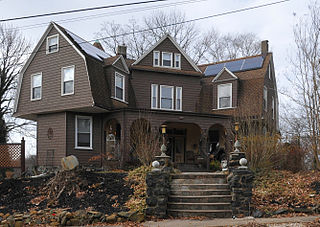
Windsor Hills Historic District is a national historic district in Baltimore, Maryland, United States. It is a cohesive residential suburb defined by rolling topography, winding, picturesque streets, stone garden walls, walks and private alley ways, early-20th century garden apartments, duplexes, and freestanding residences. Structures are predominantly of frame construction with locally quarried stone foundations. Windsor Hills developed over a period from about 1895 through 1929. The dominant styles include Shingle cottages, Dutch Colonial Revival houses, Foursquares, and Craftsman Bungalows.

Bryant Fleming House is a historic home located at Wyoming in Wyoming County, New York. It was built about 1850 and is a 1 1⁄2-story, two-by-three-bay cross-gabled vernacular Italianate-style cottage with a two-by-three-bay, 1-story rear wing. Another main building is a multi-purpose "playhouse" designed for large-scale entertaining and accommodation of overnight guests. The property includes notable landscape features that its principal owner, Bryant Fleming (1877–1946) designed and installed after he purchased the property about 1910. Also on the property is a small decorative pool with fountain, two sets of stone and concrete steps, a garden gate, and brick walls with gate posts.

Topsmead State Forest is a Connecticut state forest located in the town of Litchfield. It was formerly the summer residence of Edith Morton Chase, daughter of Henry Sabin Chase, first president of the Chase Brass and Copper Company. She left the house and its grounds to the state of Connecticut on her death in 1972. The estate house, built in 1929 to a design by RIchard Henry Dana, is a fine example of a Tudor Revival country estate house, and is listed on the National Register of Historic Places.

Rye House is a historic summer estate property at 122-132 Old Mount Tom Road in Litchfield, Connecticut. Developed in 1910 for a wealthy New York City widow, it is a prominent local example of Tudor Revival architecture, and a major example of the trend of country estate development in the region. The property was listed on the National Register of Historic Places in 2000.

The Wetherbee House is a historic cottage in Greenville, Mississippi. It is a small one-story frame-and-clapboard structure and is typical of American cottages in the late 19th century.

White Cottage, also known as Twin Oaks, is a historic house in Natchez, Mississippi, USA.

Union Cemetery Gardener's Cottage is a historic building located in Iowa Falls, Iowa, United States. When the town was platted in 1855 there was no provision for a cemetery. The women of the community formed the Social Gathering of Iowa Falls with the purpose of establishing a cemetery. They raised money and purchased the first 4.5 acres (1.8 ha) in 1860 from the three men who laid out Iowa Falls. By 1900 the organization minutes began referencing the need for the building for the sexton during stormy weather. It was not until 1918 that the Ladies Social Gathering authorized the construction of a building that they called a chapel and mortuary. The single-story American Craftsman cottage was designed by W.L. Peddicord. While it was used for a variety of functions, it appears that it was never used as a chapel. It has generally been used to house the sexton's tools, and it has been used as the cemetery office. The building was listed on the National Register of Historic Places in 2002.

The Roswell Historic District, in Roswell, Georgia in Fulton County, was listed on the National Register of Historic Places in 1974.






















